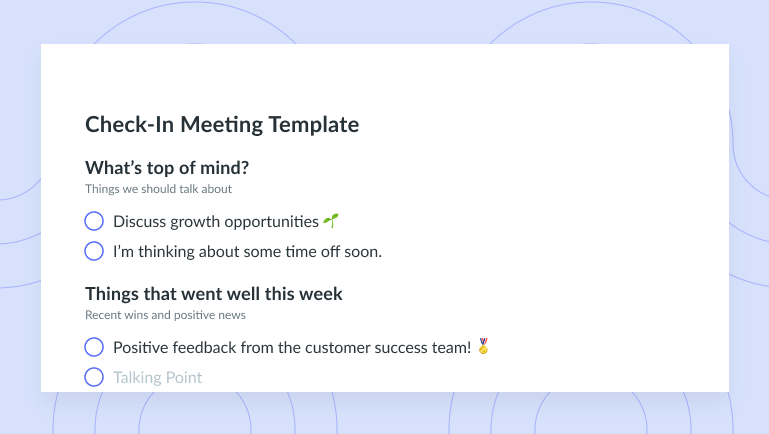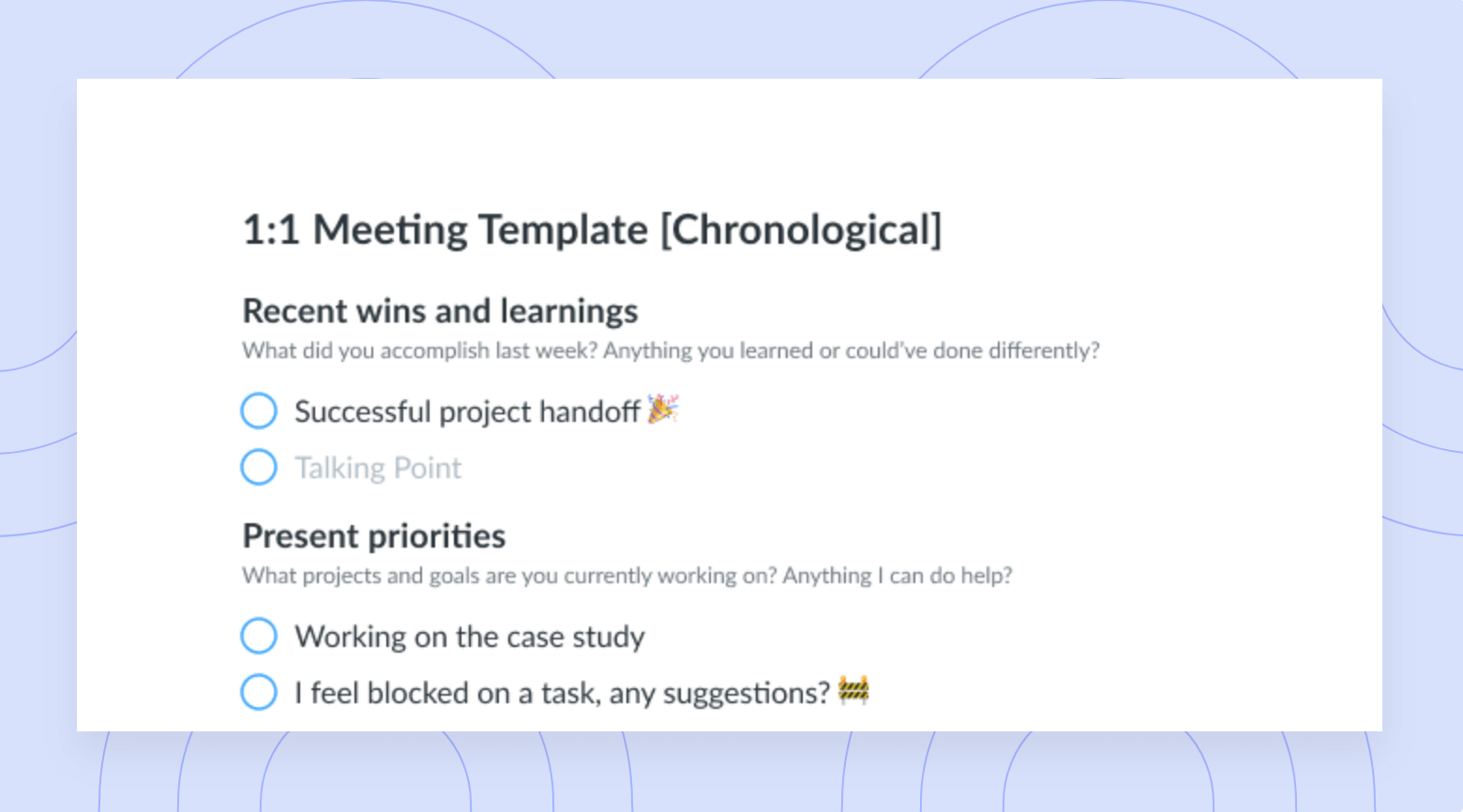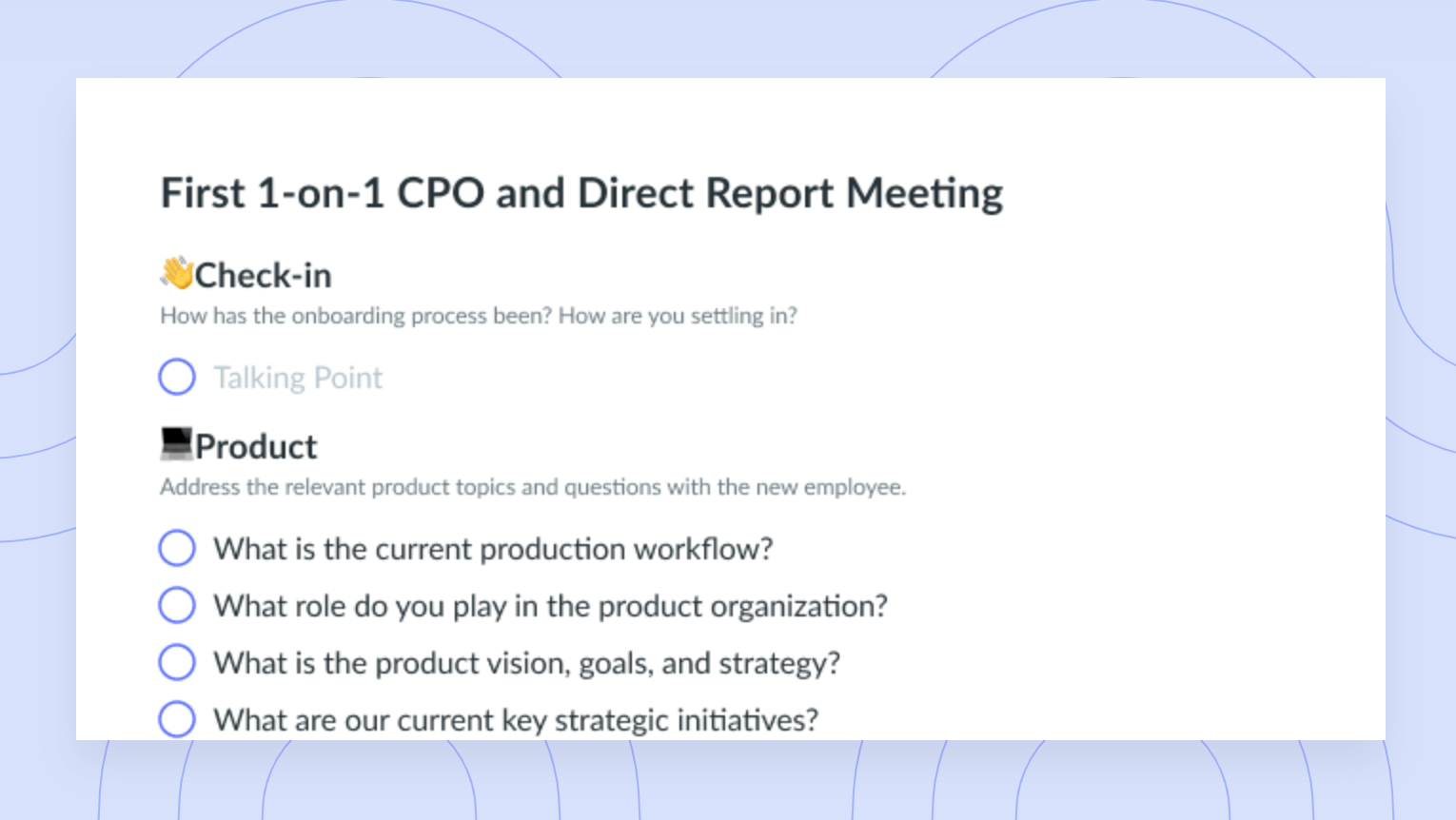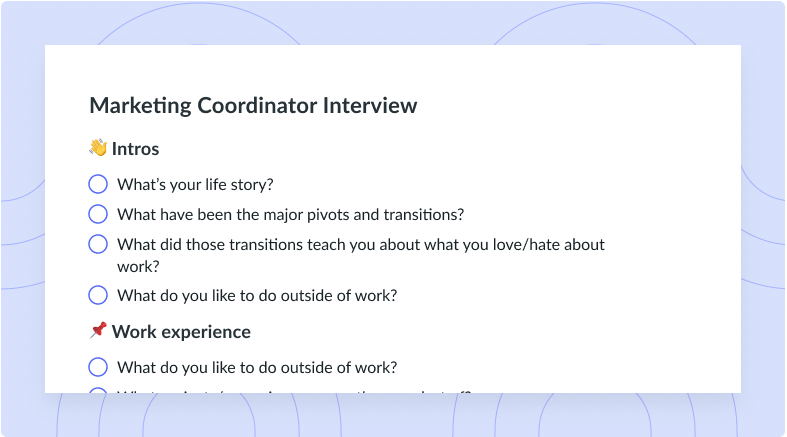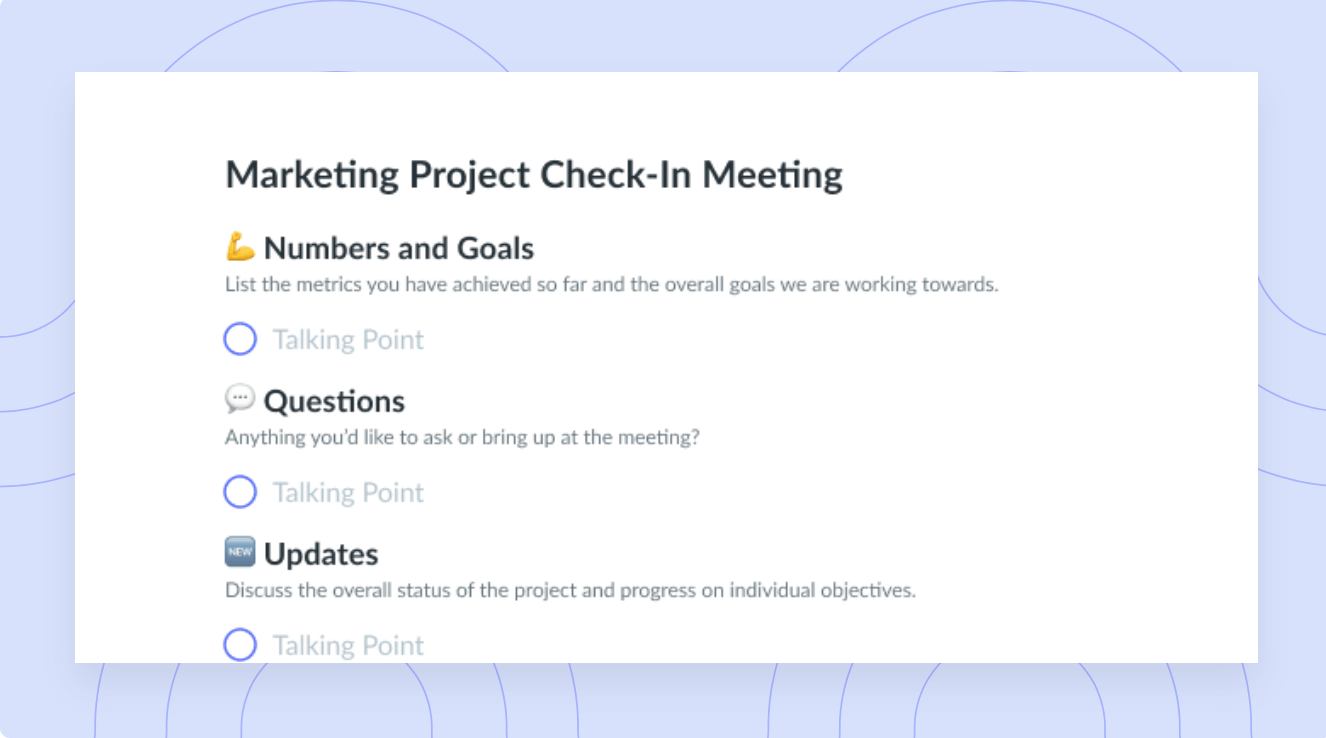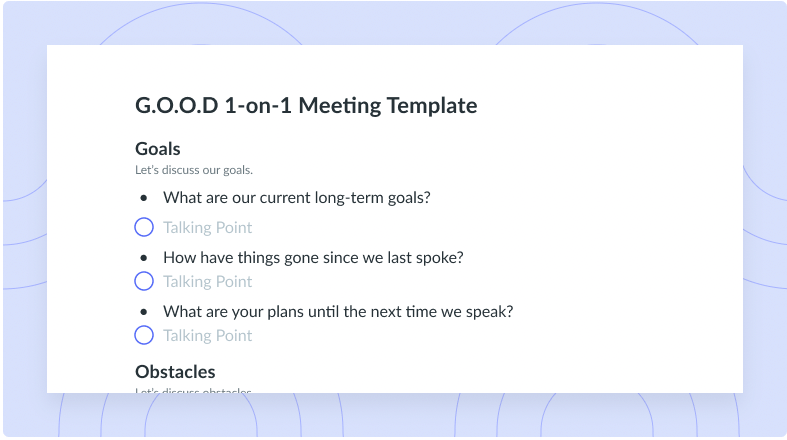One-On-One Meeting Frequency: How Often Do Great Managers Meet With Their Direct Reports?
Advice from Mark Zuckerberg, Kim Scott, Andy Grove, Julie Zhuo, and other industry leaders on the frequency of their one-on-ones with employees.
Building strong, positive relationships with your employees is like exercising to get in shape.
Think of building good relationships as a habit — for example, going to the gym. If you’re trying to reach a specific health or body goal, you’ll probably see results after two, three or four months; not after your first week (as much as most of us would love that).
Similarly, if you want to build great relationships with your employees, foster a culture of ongoing feedback and ensure there’s open communication amongst your team, you’ll have to develop the habit of meeting regularly with your fellow teammates.
There’s a lot of talk about the benefits of one-on-ones, but very little advice on the ideal frequency for these types of meetings. That’s why we summarized advice from industry leaders on the frequency of their one-on-ones with employees.
- What’s the ideal one-on-one meeting frequency?
- How long should your one-on-one meetings last?
- Tips to determine your meeting frequency
What’s the ideal one-on-one meeting frequency?
Just like you’d go to the gym on a regular basis to see results, you need to meet with your direct reports frequently to develop positive relationships and offer them your full support.
Think about all the things that happen at work during one month. An employee might go through ups and downs, experience new challenges and finish projects that might need feedback from you. An issue that is distressing someone can become a big problem if you, as their manager, don’t hear about it earlier in the month. Similarly, receiving praise can feel hollow if it’s received a month or two after accomplishing an important milestone or goal.
There’s so much to talk about, and so many things that can happen in just four weeks! (Yet some managers wait for the end of the quarter to meet with their employees). This is why experienced leaders recommend that you meet with your direct-reports biweekly or ideally, once a week.
Take Mark Zuckerberg, Facebook’s CEO, as an example. In 2016, he live-streamed his last one-on-one of the year with Facebook’s COO, Sheryl Sandberg. During the live video, he shared the secret to their business relationship’s success: one-on-one meetings, held weekly since Sandberg joined Facebook in 2008.
“We’ve had this tradition, in the last eight years or so that we’ve worked together, where every week we start the week and end the week just meeting one-on-one together, and going over everything that’s going on, and reflect on what’s going on, giving each other feedback,” said Zuckerberg.

In the video, Sandberg describes that one of her conditions to start working at Facebook was having weekly one-on-ones with Mark.
“We always know that we’re going to talk things through and we’re going to get on the same page. And when we’re not on the same page, we’re going to keep talking it through,” said Sandberg. “I do one-on-ones with the people working on my team, Mark does one-on-ones, and it reverses down. I think it’s helped the company a lot.”
Another Facebook leader that holds weekly one-on-ones with her employees is Julie Zhuo, VP of Product Design and author of The Making of a Manager:
“I recommend no less than a weekly 1:1 with every report for thirty minutes, and more time if needed,” says Zhuo. “Even if you sit next to someone and see him every day, 1:1s let you discuss topics that may never come up otherwise.”

Damon Schechter, the founder and CEO of Shipwire, has held one-on-one meetings with his direct-reports since the beginning of his career. He argues that these meetings are an essential part of growing a successful business.
“When the company and team were new, I went so far as to have 30-minute one-on-ones each day with each of my new executives,” wrote Schechter in an article for the Business Insider. “It killed half of every day for me, but helped me build a culture of trust, drive everyone to a single vision and taught me the power of delegating.”
Over time, Schechter transitioned from daily check-ins to weekly one-on-ones with his fellow employees. This frequency has become the norm for every manager in his company.
“Anytime there is tension brewing between two members of my team, I ask: when was the last time the two of you had a one-on-one? The response is usually something to the effect of: well, we’ve had trouble finding time to meet for the last 2 or 3 weeks. They then have the meeting, and the problem invariably goes away,” says Schechter.
Jason Lemkin, founder of EchoSign (acquired by Adobe) and SaaStr, is another advocate of frequent one-on-ones. In a blog post he wrote about his experiences as a manager, VP, and CEO, he describes one-on-one meetings as one of the things every manager “just gotta do.”

Lemkin recommends that you meet with every direct-report at least every two weeks:
“That enables you to make sure the team communicates. And to make sure you are helping the best on your team where you really, truly, actually can help,” says Lemkin.
Let’s go back to the exercise analogy: every person has a different routine and levels of expertise. Some people might be really good at yoga, while others excel in group sports or at weight lifting. The same concept applies to the frequency of your one-on-ones:
According to Andy Grove, former CEO of Intel, every employee has different needs, preferences and experience levels, and high-performing leaders acknowledge that. He argued that the amount of experience and knowledge that your direct reports have about the tasks they have at hand should determine the frequency of your one-on-ones.
In other words, it’s essential that you determine your employees’ task-relevant maturity and as a consequence, how often each of them need to meet with you. Not everyone will need a weekly one-on-one, but your newest employee or someone tackling a brand new project might.
“The most effective management style in a specific instance varies from very close to very loose supervision as a subordinate’s task maturity increases,” said Grove. “Accordingly, you should have one on ones frequently (for example, once a week) with a subordinate who is inexperienced in a specific situation and less frequently (perhaps once every few weeks) with an experienced veteran.”

Grove, who is considered a pioneer in the technology industry, was a major proponent of one-on-ones. He argued that the skill of creating and maintaining a business could be summed up in a single word: “managing.” And that’s precisely what frequent one-on-ones with your team empower you to do.

Never forget what was discussed
Show your direct reports that you care by remembering what they said during past meetings. With Fellow, you can see a history of every 1-on-1 conversation you’ve had and ensure that you’re staying focused on important decisions and action items.

How long should your one-on-one meetings last?
A 10-minute workout or a quick walk around the park won’t give you the same results as one full hour of exercise. Similarly, a well-planned one-on-one will be more likely to bring your team the results that you want.
Several books, including The Power of Habit by Charles Duhigg, talk about the importance of scheduling actions, so they become ingrained practices. Following this logic, you should schedule recurring one-on-one blocks on your calendar to ensure that you’re supporting employees and developing positive work relationships.
According to Andy Grove, managers should block approximately one hour of their day to meet with their direct report:
“Anything less, in my experience, tends to make the subordinate confine himself to simple things that can be handled quickly,” said Grove.
Think about it. If you had a big problem you wanted to discuss, would you bring it up in a meeting that lasts only fifteen minutes? You probably wouldn’t.
“The subordinate must feel that there is enough time to broach and get into thorny issues,” wrote Grove.
This is why, according to Grove, one-on-one meetings should last approximately one hour.
If you manage a large team of people, scheduling one hour for each meeting might seem like a lot of time. Some managers plan 30 to 45-minute sessions to check-in with their direct reports. The important thing is to build the habit, and not let it go.
Kristi Hedges, author of The Power of Presence, wrote an article titled The secret to effective one-on-one meetings with direct reports. The author argues that committing to a schedule allows managers and employees to prepare better agendas and take one-on-one discussions more seriously.

She also advises that managers schedule some free time after each meeting, so they can end the conversation without feeling rushed:
“Don’t schedule between back-to-back meetings so you come late and have to cut out on the dot,” says Hedges. “One trick: schedule meetings for 45 minutes rather than an hour.”
In Radical Candor, Kim Scott mentions that her preferred one-on-one length is fifty minutes. However, she acknowledges that this is not realistic for some companies— where managers have between ten and twenty direct reports.
“If you’re in that situation, I recommend twenty-five minutes every other week with each direct report,” says Scott. “Also, see if you can create some leadership opportunities for the people who work for you and reduce the number of direct reports you have.”

Tips to determine your one-on-one meeting frequency
The world’s most successful managers have frequent one-on-one meetings with their reports — which are between 30 and 60 minutes long. To determine how often and how long your one-on-ones should be, you can ask yourself the following questions:
1 How many direct reports do I have?
This will help you determine the length of your meetings (the recommended times are 45-60 minutes if you have five or less direct reports, and 25-30 minutes if you manage more than five employees).
2 What is each person’s task-relevant maturity?
This will help you determine the frequency of your meetings. As we explained before, you should meet every week with reports that are tackling a new project or skill, and biweekly with more experienced employees.
3 Are there any specific issues or goals I need constant updates on?
Some teams move at a faster pace than others. As Andy Grove states in High Output Management, you might have to meet with your direct reports more frequently if you’re in marketing or sales than if you work on environmental research.
Once you’re done answering these questions, open your calendar and schedule recurring one-on-ones with all your direct reports.
These meetings will empower you to get to know your team, stay up to date with their projects, and ensure they feel your full support.






![How Many Direct Reports Should a Manager Have? [+ Free Template]](https://fellow.app/wp-content/uploads/2022/06/How-Many-Direct-Reports-Should-a-Manager-Have-2.jpg)


